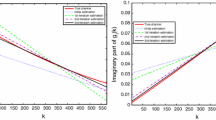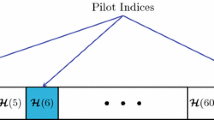Abstract
This paper considers the channel estimation method in the case of a high mobility communication in orthogonal frequency-division multiplexing (OFDM) systems. In this paper, several successive OFDM symbols experienced channel are treated as a window. The polynomial approximation of the channel parameters in the time domain is considered. We show that the low order polynomials are good enough to model the channel within a window. Hence the interpolation performing over a whole window profits pilot reduction. Moreover, the method has an advantage of computational complexity because of the low order polynomial approximation and without the requirement of inter-carrier interference mitigation. The method is derived with the least-square approach for polynomial interpolation of arbitrary order. Simulation results show that the proposed method is robust to high Doppler frequency and enhancing the transmission efficiency.






Similar content being viewed by others
References
Li, Y., & Cimini, L. J. (2001). Bounds on the interchannel interference of OFDM in time varying impairments. IEEE Transactions on Communications, 49(3), 401–404.
Chen, S., & You, T. (2004). Intercarrier interference suppression and channel estimation for OFDM systems in time-varying frequency-selective fading channels. IEEE Transactions on Consumer Electronics, 50(2), 429–435.
Tong, L., Sadler, B., & Dong, M. (2004). Pilot-assisted wireless transmissions: general model, design criteria, and signal processing. IEEE Signal Processing Magazine, 21(6), 12–25.
Mostofi, Y., & Cox, D. (2005). ICI mitigation for pilot-aided OFDM mobile system. IEEE Transactions on Wireless Communications, 4(2), 765–774.
Liu, G., Zhidkov, S. V., Li, H., et al. (2012). Low-complexity iterative equalization for symbol-reconstruction-based OFDM receivers over doubly selective channels. IEEE Transactions on Broadcasting, 58(3), 390–400.
Tang, Z., Leus, G., & Banelli, P. (2006). Pilot-assisted time-varying OFDM channel estimation based on multiple OFDM symbols. Proceedings of the IEEE SPAWC Cannes: Signal Processing Advances in Wireless Communications,. doi:10.1109/SPAWC.2006.346364.
Hijazi, H., & Ros, L. (2009). Polynomial estimation of time-varying multipath gains with intercarrier interference mitigation in OFDM systems. IEEE Transactions on Vehicular Technology, 58(1), 140–151.
Zhou, W., & Lam, W. H. (2010). Channel estimation and data detection for OFDM systems over fast-fading and dispersive channels. IEEE Transactions on Vehicular Technology, 59(3), 1381–1392.
Stamoulis, A., Diggavi, S. N., & Al-Dhahir, N. (2002). Intercarrier interference in MIMO-OFDM. IEEE Transactions on Signal Processing, 50(10), 2451–2464.
Fujita, T., Ohta, A., Onizawa, T., et al. (2005). A reduced-complexity signal detection scheme employing ZF and K-best algorithms for OFDM/SDM. IEICE Transactions on Communications, E88-B(1), 66–75.
COST 207 Management Committee. (1989). COST 207: Digital land mobile radio communications. Bruxelles: Commission of the European Communication.
Acknowledgments
This work was partially supported by the Ministry of Science and Technology of the Taiwan, ROC (Grant No. NSC 103-2218-E-539 -001).
Author information
Authors and Affiliations
Corresponding author
Rights and permissions
About this article
Cite this article
Jan, YH. Transmission Efficient Channel Estimation for OFDM System Under Multi-path Fast Fading Channel. Wireless Pers Commun 84, 1561–1575 (2015). https://doi.org/10.1007/s11277-015-2703-9
Published:
Issue Date:
DOI: https://doi.org/10.1007/s11277-015-2703-9




